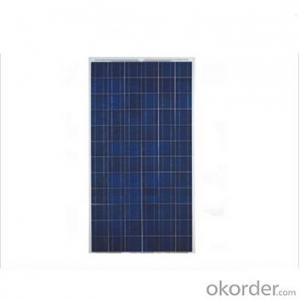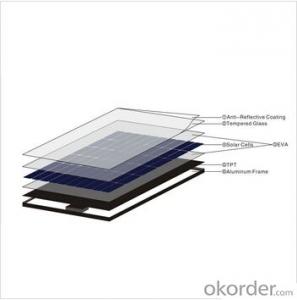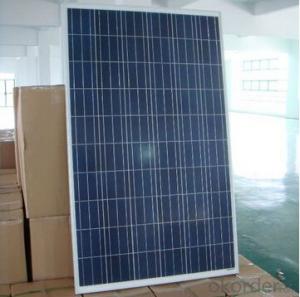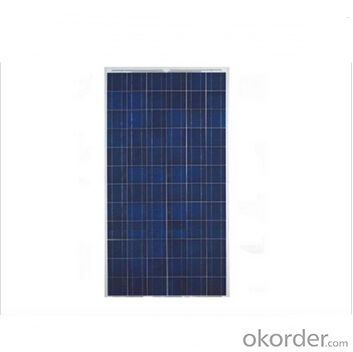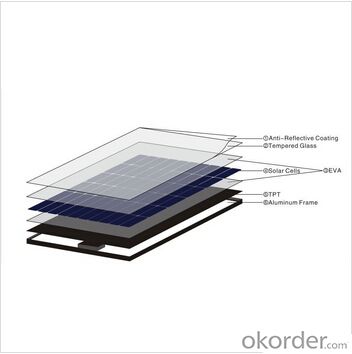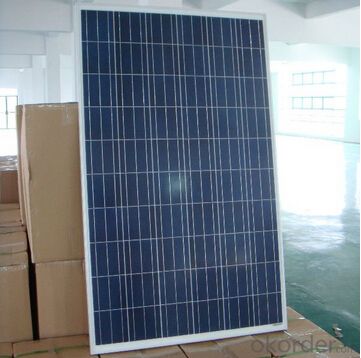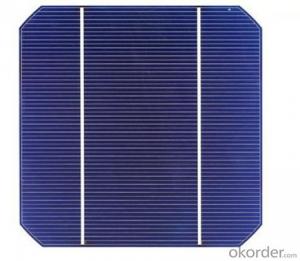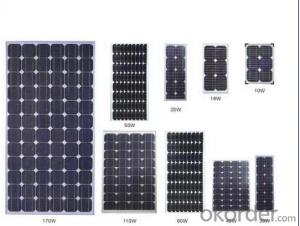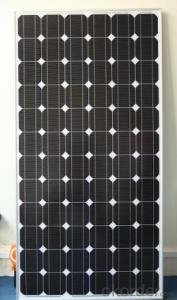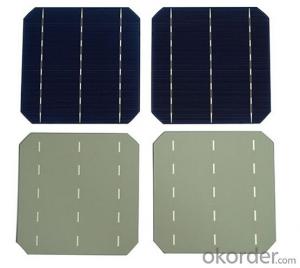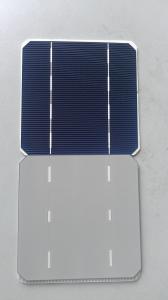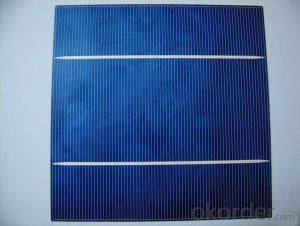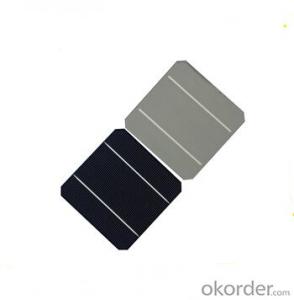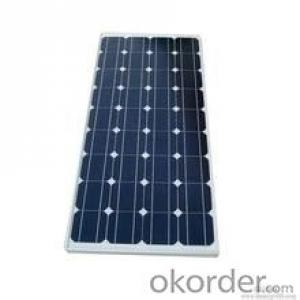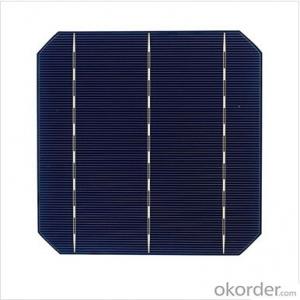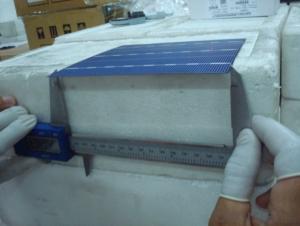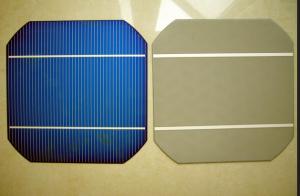Cylindrical Grade-A Monocrystalline Solar Cells
- Loading Port:
- Shanghai
- Payment Terms:
- TT OR LC
- Min Order Qty:
- 50 pc
- Supply Capability:
- 10000 pc/month
OKorder Service Pledge
OKorder Financial Service
You Might Also Like
Product Description:
Solar Monocrystalline Series Panels
Introduction of Solar Monocrystalline Series Panels
CNBM Solar photovoltaic (PV) Panel is designed for large electrical power requirements. It is the optimal choice for both on-grid and off-grid power systems. CNBM Solar panel offers high performance of power per square foot of solar array. Monocrystalline silicon(c-Si): often made using the Czochralski process. Single-crystal wafer cells tend to be expensive, and because they are cut from cylindrical ingots, do not completely cover a square solar cell module without a substantial waste of refined silicon. Hence most c-Si panels have uncovered gaps at the four corners of the cells.
Characteristics of Solar Monocrystalline Series Panels
I Solar Cell : High efficiency crystalline solar cell. Even if under the weak light, the solar module can produce maximum power output.
II Tempered glass (toughened glass): Anti-reflecting coating and high transmission rate glass increase the power output and mechanical strength of solar module.
III EVA and TPT: Using high quality EVA and TPT to prevent destroying and water.
IV AI frame: Without screw, corner connection. 6 holes on the frame can be installed easily.
V Junction box: Multi function junction box with water proof.
VI Long lifetime: ≥25 years; Less power decrease
VII Good performance of preventing from atrocious weather such as wind and hails.
VIII Resisting moisture and etching effectively, not effected by geology.
Standard Test Conditions of Solar Monocrystalline Series Panels
The opto-electrical specifications shown below are stabilized values being measured at Standard Test Conditions, Irradiance: 1000W/m2, Spectrum: AM1.5 at 25°C, The info below is subject to manufacturing tolerances. Where appropriate minutes of measurement are available and are used for the dimensioning of the installation.
Advantages of Solar Monocrystalline Series Panels
• CNBM Solar performance guarantees for 25 years
• 12 years guarantee for workmanship
• Timeliness of delivery
CNBM International Corporation's products including Monocrystalline Solar Panel, Polycrystalline Solar Panel have received and enjoyed famous reputation in many countries and regions in the world .As a solar panel supplier in China, we strive to provide our customers with excellent service, superior products and unmatched value.
Characteristics of Solar Monocrystalline Series Panels
Max Power Voltage Vmp (V) | 18.4V | 17.6V |
Max Power Current Imp (A) | 6.52A | 7.39A |
Open Circuit Voltage Voc (V) | 23.0V | 22.2V |
Short Circuit Current Isc (A) | 6.97A | 7.90A |
Max Power Pm (W) | 120W | 130W |
Temperature Coefficient of Cells
NOCT | 47℃±2℃ |
Temperature Coefficients of Isc (%/℃) | 0.064 |
Temperature Coefficients of Voc (%/℃) | -0.33 |
Temperature Coefficients of Pmp (%/℃) | -0.45 |
Mechanical Data Solar Monocrystalline Series
Power | 120W/130W |
Dimension | 1190/1470×670×30mm |
Weight | 9.5kg/11.7kg |
Tolerance | ±3% |
The dimension of the modules can be changed according to the demand of clients
Limits
Operating Temperature | –40 °C to +85°C |
Storage Temperature | –40 °C to +85°C |
Max System Voltage | 700V |
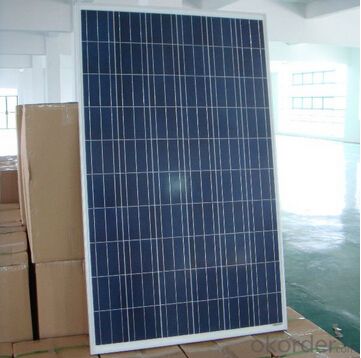
FAQ
We have organized several common questions for our clients,may help you sincerely:
1. What’s price per watt?
A: It’s depends on the quantity, delivery date and payment terms of the order. We can talk further about the detail price issue. Our products is high quality with lower price level.
2. Can you tell me the parameter of your solar panels?
We have different series of cells with different power output, both from c-si to a-si. Please take our specification sheet for your reference.
3. How do you pack your products?
We have rich experience on how to pack the panels to make sure the safety on shipment when it arrives at the destination.
4. Can you do OEM for us?
Yes, we can.
5. How long can we receive the product after purchase?
In the purchase of product within three working days, We will arrange the factory delivery as soon as possible. The perfect time of receiving is related to the state and position of customers. Commonly 7 to 10 working days can be served.
- Q: How do solar cells perform in areas with high levels of volcanic ash?
- Solar cells may not perform optimally in areas with high levels of volcanic ash. The ash particles can accumulate on the surface of the solar cells, blocking sunlight and reducing their efficiency. Regular cleaning and maintenance may be required to ensure the cells continue producing electricity effectively.
- Q: Can solar cells be used in remote sensing devices?
- Yes, solar cells can be used in remote sensing devices. Solar cells convert sunlight into electricity, which can power various sensors and data collection devices used in remote sensing applications. The use of solar cells ensures that these devices can operate independently and sustainably in remote locations without the need for external power sources.
- Q: How can solar cells be used in residential applications?
- Solar cells can be used in residential applications by installing them on rooftops or in open spaces to harness sunlight and convert it into electricity. This electricity can then be used to power various household appliances and lighting systems, reducing reliance on traditional energy sources and potentially lowering electricity bills. Additionally, excess electricity generated by solar cells can be stored in batteries or fed back into the grid, further promoting sustainability and energy independence for residential properties.
- Q: How to get high voltage, high current output of solar cells
- A reasonable series of parallel can be, and increase the number of sub-batteries
- Q: Can solar panels be charged with light?
- amorphous silicon, gallium arsenide, selenium and other copper. Their power generation principle is basically the same, now crystal silicon as an example to describe the photovoltaic power generation process. P-type crystalline silicon doped with phosphorus can be obtained N-type silicon, the formation of P-N junction.
- Q: Can solar cells be used for powering electric vehicle charging stations?
- Yes, solar cells can be used for powering electric vehicle charging stations. Solar panels can generate electricity from sunlight, which can then be used to charge electric vehicles at charging stations. This helps to reduce dependence on non-renewable energy sources and promotes the use of clean and sustainable energy for transportation.
- Q: How do solar cells handle power fluctuations?
- Solar cells handle power fluctuations through a process called maximum power point tracking (MPPT), which optimizes the output power of the cell. MPPT algorithms continuously monitor the voltage and current of the solar cell and adjust the load resistance to ensure that the cell operates at its maximum power point, even in the presence of fluctuations in solar irradiance or temperature. This allows solar cells to efficiently convert sunlight into electricity and adapt to changing environmental conditions.
- Q: How do solar cells perform in areas with high levels of dust storms?
- Solar cells may experience reduced performance in areas with high levels of dust storms due to the accumulation of dust particles on their surface. These dust particles can block sunlight, reducing the amount of energy that can be converted into electricity. Regular cleaning and maintenance of the solar panels may be required to ensure optimal performance in such environments.
- Q: What is the average cost of a solar cell?
- The average cost of a solar cell varies depending on factors such as the type of cell, its efficiency, and the size of the installation. However, as of 2021, the average cost is approximately $0.30 to $0.40 per watt for residential installations and $0.20 to $0.30 per watt for utility-scale installations. It's important to note that these costs have been decreasing over the years due to advancements in technology and increased adoption of solar energy.
- Q: How do solar cells handle electromagnetic interference?
- Solar cells are typically designed to be resistant to electromagnetic interference by incorporating shielding and filtering techniques. These measures help to minimize the impact of electromagnetic waves from external sources, ensuring that the solar cells continue to operate efficiently and produce electricity without interference.
Send your message to us
Cylindrical Grade-A Monocrystalline Solar Cells
- Loading Port:
- Shanghai
- Payment Terms:
- TT OR LC
- Min Order Qty:
- 50 pc
- Supply Capability:
- 10000 pc/month
OKorder Service Pledge
OKorder Financial Service
Similar products
Hot products
Hot Searches
Related keywords
